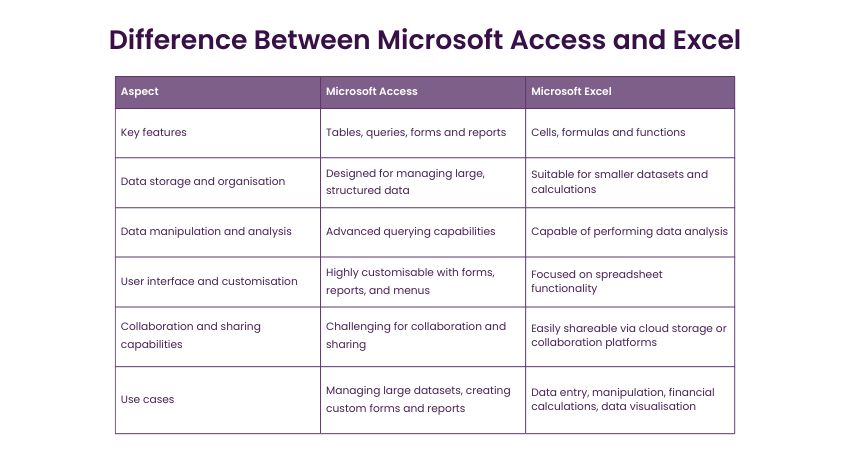We may not have the course you’re looking for. If you enquire or give us a call on +36 18508731 and speak to our training experts, we may still be able to help with your training requirements.
Training Outcomes Within Your Budget!
We ensure quality, budget-alignment, and timely delivery by our expert instructors.

Microsoft Access and Microsoft Excel are two popular software applications developed by Microsoft Corporation. While both serve as valuable tools for managing data and organising information, they have distinct differences in terms of their purpose, features, and use cases. This is why people need to make an informed choice between Microsoft Access or Excel. In this blog, we will explore the Difference Between Microsoft Access and Excel to help you understand which application is more suitable for your specific needs.
Table of Contents
1) What is the Difference Between Microsoft Access and Excel?
a) Key features
b) Data storage and organisation
c) Data manipulation and analysis
d) User interface and customisation
e) Collaboration and sharing capabilities
f) Use cases
2) Conclusion
What is the Difference Between Microsoft Access and Excel?
Before we delve into the Difference Between Microsoft Access and Excel, we will first define What is Microsoft Access and Excel – beginning with the former. Microsoft Access is defined as a Relational Database Management System (RDBMS) that allows users to create and manage databases. Microsoft Excel, on the other hand, is a spreadsheet software that primarily focuses on data analysis, calculations, and visualisation. Microsoft Excel and Access differ in several ways, some of which we have explained as follows:

Key features
Access, a robust Database Management System, hosts several features such as tables, queries, forms, and reports. It has a customisable, user-friendly interface that supports data relationships and ensures referential integrity – allowing users to maintain data consistency.
Excel, on the other hand, is a spreadsheet software that offers features such as cells, formulas, and functions. It provides a set of tools for data analysis and data visualisation, such as various chart types and customisation options – which aids users in interpretation and presentation.
Data storage and organisation
Access is designed as a relational Database Management System (RDBMS) and excels at storing and managing large amounts of structured data. It allows users to create multiple tables, establish relationships between them, and enforce data integrity rules.
Excel, on the other hand, is a powerful spreadsheet software that is better suited for storing smaller datasets. It provides a grid-like interface where users can organise data into rows and columns.
Data manipulation and analysis
Access provides advanced querying capabilities, making it easier to extract specific subsets of data from a database. It offers tools for filtering, sorting, and performing calculations on data.
Excel offers a range of built-in functions and formulas for data manipulation and analysis. It allows users to perform complex calculations, create custom formulas, and apply functions to analyse data trends and patterns.
Enhance your Microsoft Access skills with our comprehensive Microsoft Access Masterclass Course!
User interface and customisation
Access offers a more robust and customisable user interface compared to Excel. It allows users to create custom forms, reports, and navigation menus tailored to their specific requirements. Excel's interface is primarily focused on spreadsheet functionality, and while it offers some customisation options, they may not be as extensive as those available in Access.
Collaboration and sharing capabilities
Access databases are usually stored on a local or network drive, which can make collaboration and sharing more challenging. Access databases require proper setup and configuration for multi-user access.
Excel, on the other hand, allows for easier collaboration and sharing. Users can share Excel spreadsheets via cloud storage services or collaborative platforms, enabling real-time collaboration, version control, and simultaneous editing.
Enhance your Excel Skills with our Microsoft Excel Masterclass Course – sign up now!
Use cases
Access is ideal for managing large datasets that require a relational database structure. It is commonly used for building and maintaining complex databases, establishing relationships between tables, and enforcing data integrity. Access is best suited for businesses or projects that involve managing extensive data and require customised forms and reports for data entry and analysis.
Excel is widely used for data entry and manipulation tasks. It offers a familiar spreadsheet interface where users can input, edit, and format data efficiently. Excel is highly valuable in finance and accounting for performing various calculations, financial modelling, budgeting, and forecasting. Its built-in functions simplify complex financial calculations. Its charting capabilities make Excel a preferred tool for data visualisation, as users can create dynamic charts and graphs to represent data trends and patterns effectively.

Conclusion
In conclusion, Microsoft Access and Excel are both powerful applications with distinct purposes and features. Understanding the Difference Between Microsoft Access and Excel can help you determine which software application best suits your needs based on the nature of your data and the tasks you need to accomplish.
Take your Microsoft Office skills to the next level – sign up for our Microsoft Office Training Courses today!







 Top Rated Course
Top Rated Course



 If you wish to make any changes to your course, please
If you wish to make any changes to your course, please


